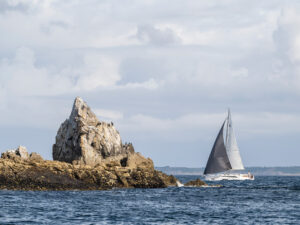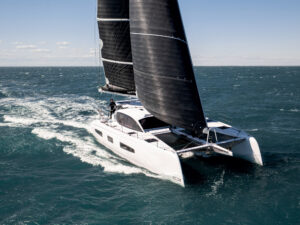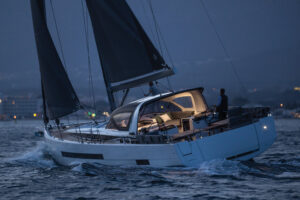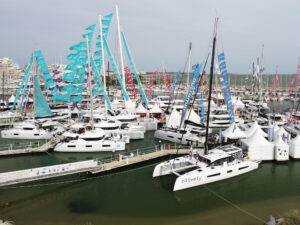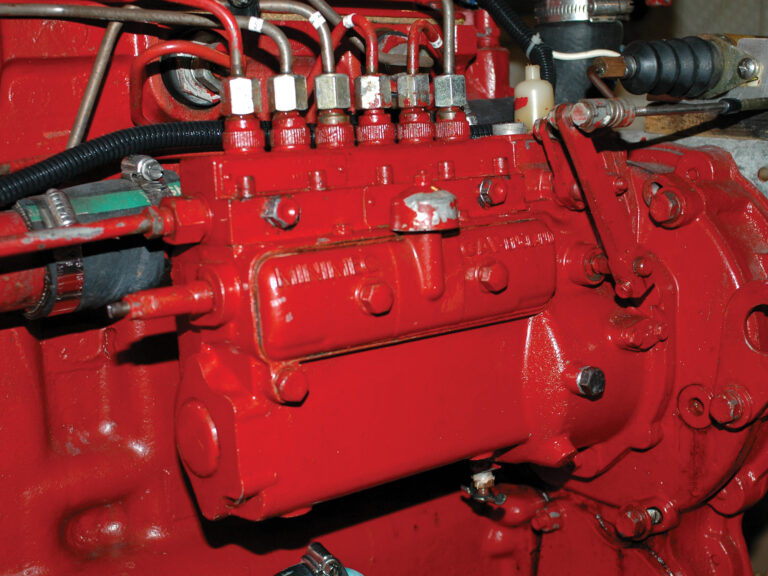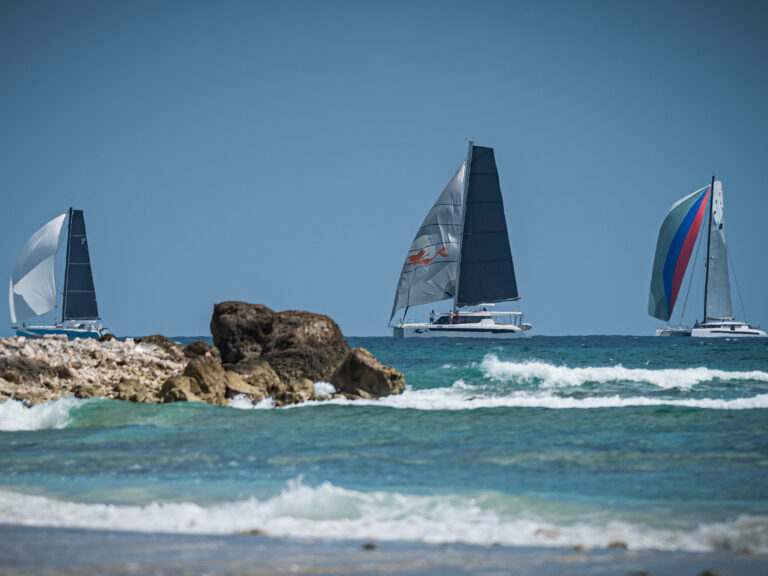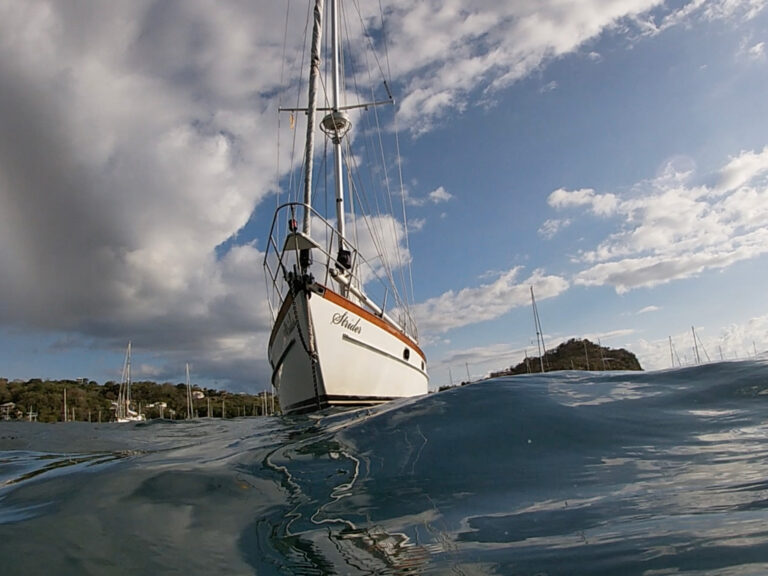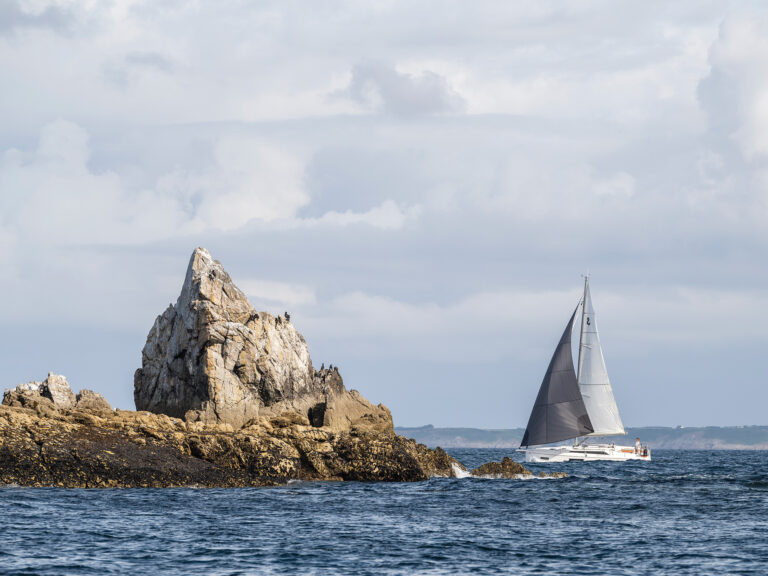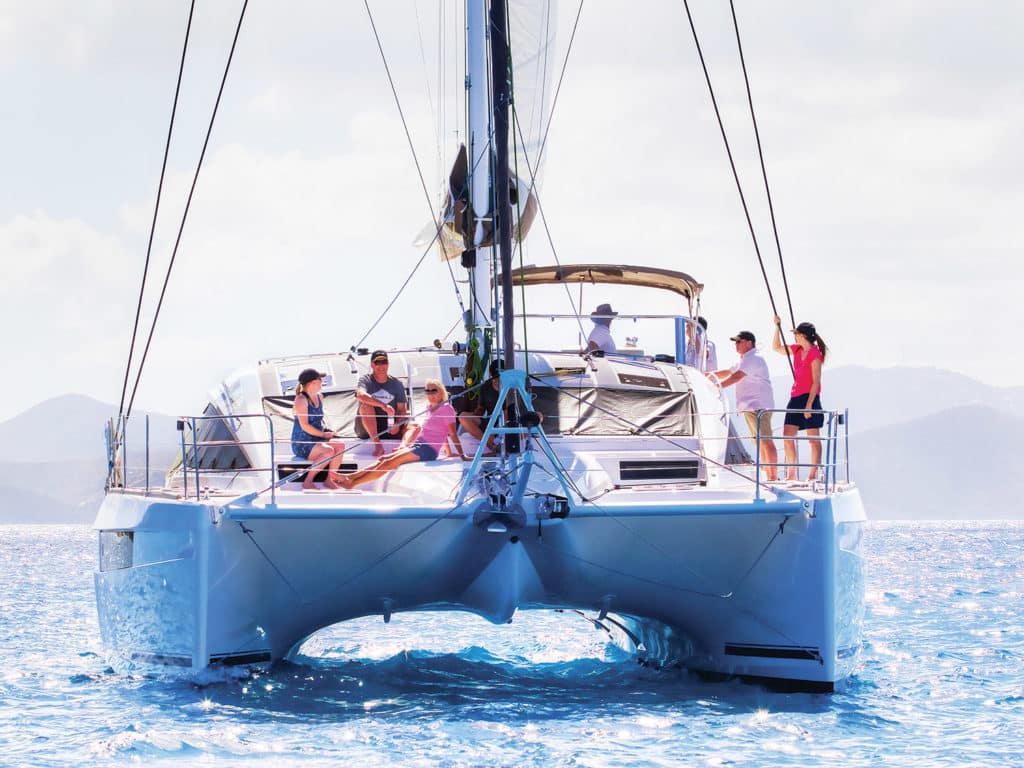
The dream of living aboard a catamaran and cruising is an easy one to picture—sharing sundowners with friends in a spacious cockpit, sprightly sails through the islands, sleeping quarters in separate hulls—but the steps of making this happen? That’s a bit more complicated.
In early April 2019, I had the opportunity to meet several couples who were just at the cusp of making this dream their reality. They were in the British Virgin Islands by invitation to attend Privilege Academy, an orientation program designed for new and prospective owners of Privilege Catamarans to teach them the ins and outs of cruising on a cat. Trainees paid their travel expenses but “tuition” was complimentary. With just three days for class, there was going to be a lot to cover.
Privilege Academy is hosted by Vacances Sous Voiles (VSV), a yacht-management and charter company and the North American dealer for Privilege Catamarans. VSV is based in Montreal, Canada, and the company’s charter base is located at the Nanny Cay Marina in the BVI—our “campus” for the Academy. In the days leading up to the event, I was certainly anticipating some warm Caribbean weather, but what I was really looking forward to was meeting the attendees. What was their sailing experience and what are their cruising plans? What made them decide on a catamaran? Were they apprehensive about anything? These were the questions rattling around my brain as I made my way from Rhode Island to Tortola to meet with marine-industry veteran and Privilege Catamaran’s North American sales rep, Rob Poirier, before the Academy started the next day.
“My goal for this program is to take the stress out of delivery day and make the first year of ownership as painless as possible,” Rob said. “The more people know about their boat, the more they enjoy it.” He plans to offer this course a couple times a year, or more if needed. During the next three days, the eight guests—students really—would have the opportunity to learn about each system on the boat, explore every locker and compartment, put the cat through its paces on Sir Francis Drake Channel, and even try their hand at docking the 50-foot Privilege 500.
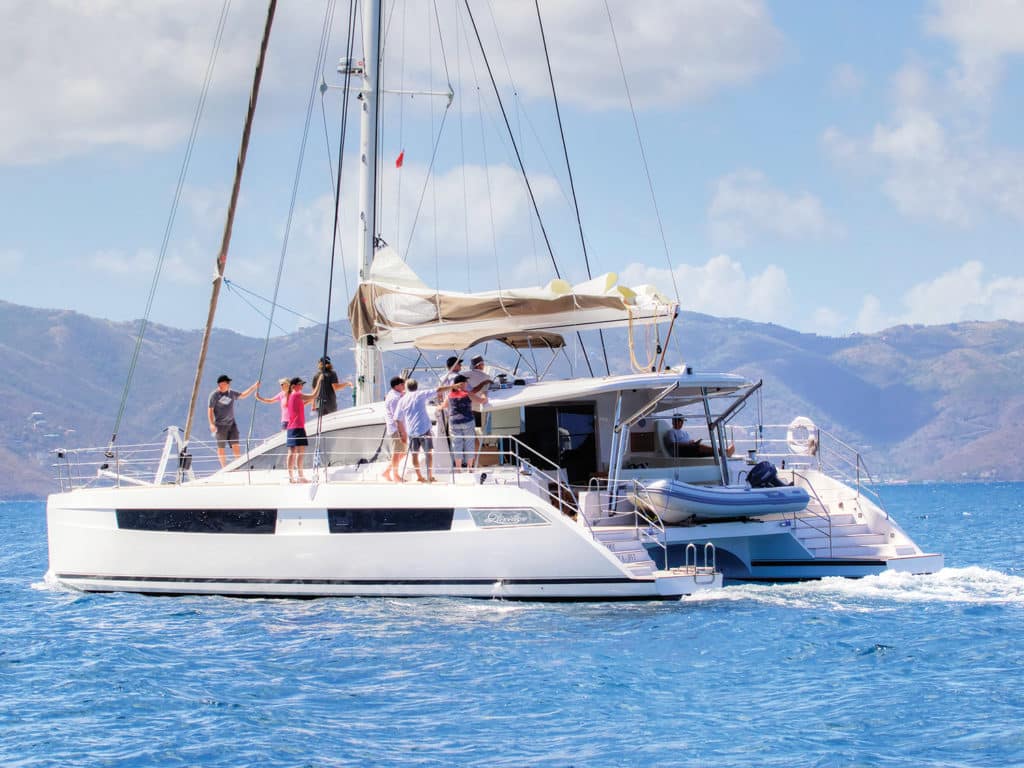
It all started off on a fun note Wednesday night with a group dinner hosted by VSV at the Bananakeet Cafe. It was here over cocktails and enjoying a perfect sunset that I met the students and the rest of the VSV crew. Not a bad way to ease into things.
The student body turned out to be a diverse one. I had assumed that everyone would probably be moving up from other cruising boats, which turned out to be only partly accurate.
“I guess I’m moving from the dark side to the light!” said Rob Sissons, a native of Alberta, Canada. His previous boat was a 65-foot trawler that he used to cruise along the west coast from California to Alaska. Other than going from a trawler to a sailboat (doesn’t it usually work the other way?) the other thing that surprised me about Rob was that the first day we took the boat out was the first time he had ever been sailing on a cat. I wondered what made him take this leap, especially since he would be taking delivery of his own boat in France the following month. He shrugged and said, “I liked the way the cats sat at anchor, not rocking back and forth like the monohulls,” recalling his time cruising on his trawler. Rob at least won’t be alone in his journey with his new cat—he brought along his boat’s newly minted captain, Brett, for classes too.
RELATED: It’s all there in the BVI
Iris and Volker Braun are from Austria and also moving to a cat from a powerboat. “We want to have the space and comfort of a powerboat combined with a good sailing boat—and we don’t really like heeling,” Iris said. Eager to pick up as much information as possible during the training, despite a slight language barrier, Iris took constant notes and photos of details. “I want to be 100 percent,” she said with a laugh. The Brauns’ boat is on order and scheduled for delivery in about a year. Having only spent time on the 500, a sistership to the couple’s new boat, during the recent Miami International Boat Show, for them, the few days in the BVI was an opportunity to really get to know “their” cat before launch day. “It’s so good for me to see it all together and feel it,” said Iris. “It’s just great!”
Unlike the Brauns and Rob Sissons, the other two couples are already dedicated sailors, although only on monohulls so far. Paul and Leslie Wollmann are from Bermuda and have sailing in their blood, albeit of the more competitive variety. One of their daughters, Cecilia Wollmann, represented Bermuda in sailing in the 2016 Olympics; Leslie participated in a Newport Bermuda Race, and Paul was on his way to Charleston Race Week right after wrapping up things in Tortola. When I met the Wollmanns, Leslie admitted that they were still not completely decided between a monohull or a catamaran for their cruising plans. She likes the way monohulls sail, but would really like the space of a cat. However, by the end of our three days, Paul seemed pretty convinced that a catamaran was the direction they would go.
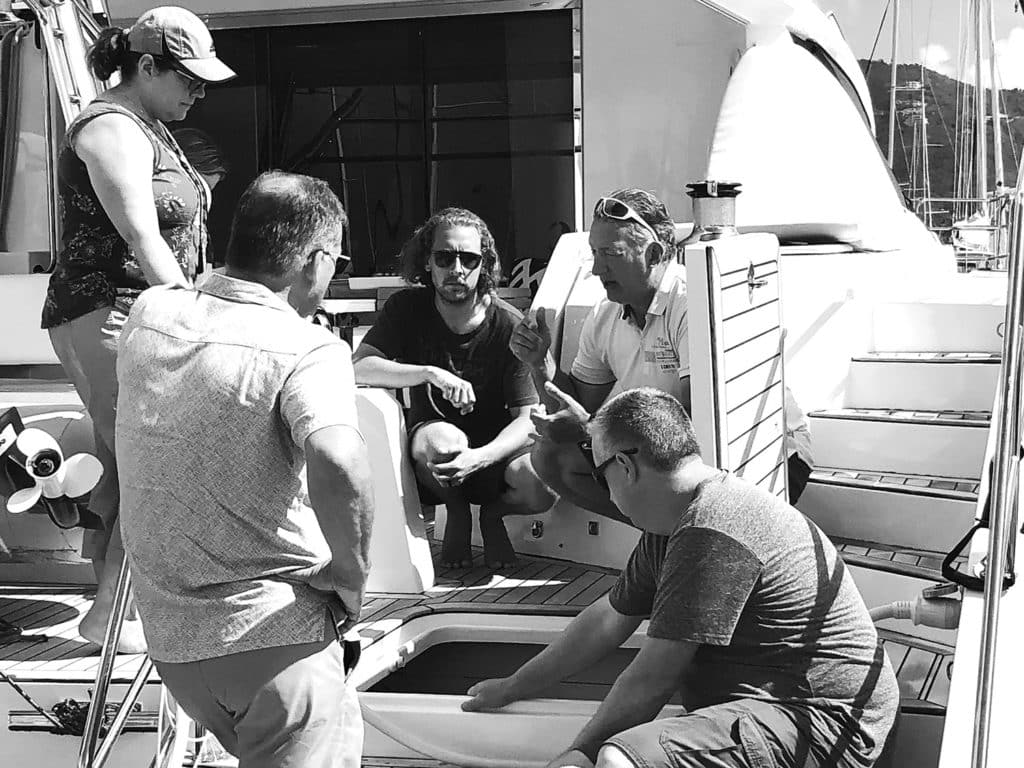
Ken and Kathleen Reedel were the sole Americans in the group and also the only ones moving up from another cruising sailboat. The couple was in the process of selling their 3-year-old Beneteau Oceanis 48, which they cruised to the islands in the 2018 ARC Caribbean 1500 rally. Kathleen described it as a rough passage where they had to divert to Bermuda due to weather on their way to the BVI, “and our poor cats were miserable!” So what are the aspects they are looking forward to the most with living aboard a catamaran? Ken listed off a few: “Space, including a large, sheltered aft deck, walkaround berths, not heeling under sail and stability at anchor.”
The instruction aboard the boat for the first two days was divided so that the mornings were spent learning about the systems and the afternoons were for sailing. Not a bad school day really. The students were broken up into two groups of four, with half going with Rob Poirier to learn about plumbing and water systems, and the other half learning about the electrical systems with Richard Lacelle, who along with his wife, Helen Goulet, owns VSV. After an hour or so, the groups switched places.
Modern cruising cats are complicated, and having a detailed walkthrough of each of the systems and the opportunity to ask every question you can think of is invaluable. Richard started his electrical training with a question: “How many ways does this boat have to generate power?” As the students listed off the different devices (genset, solar panels, shore power, alternator), each became a starting point for understanding the complete system and how everything works together. Discussion moved along to the batteries, inverter, the panel, control relays, the intricacies of hertz and volts, and whether or not Rob Sissons could run his margarita machine.
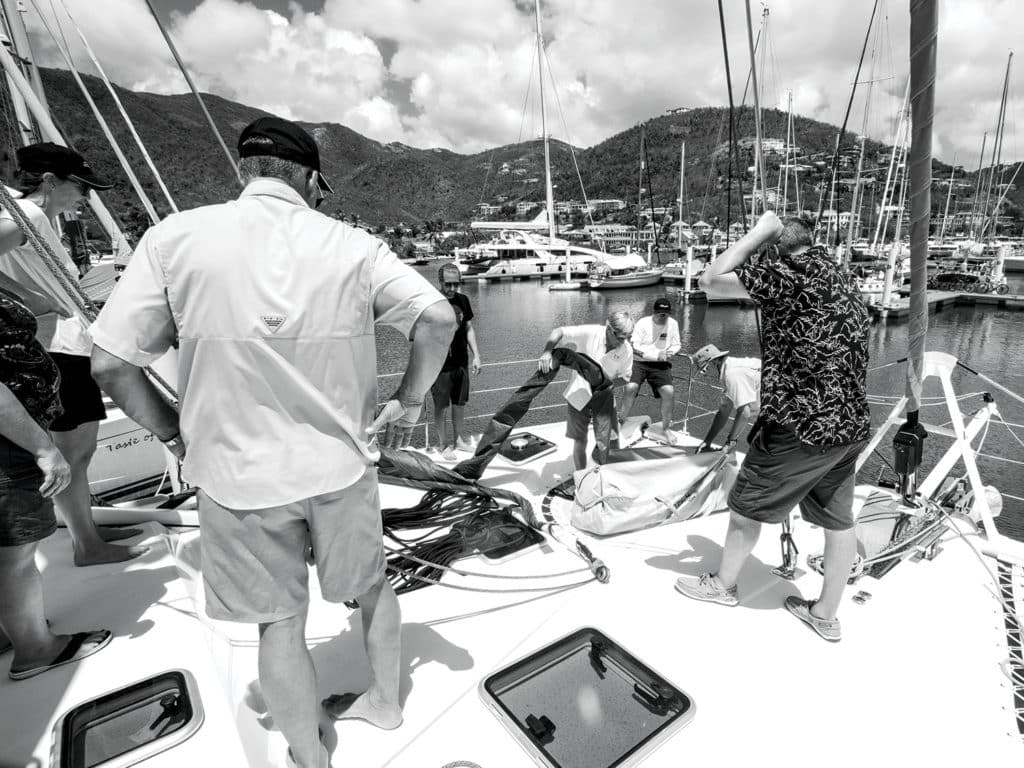
Rob Poirier’s group meanwhile was busy learning about the water systems, from watermaker to tanks to shower sumps and bilge pumps. There was a lot to take in.
To augment the owner’s manuals that come with the new boats, Rob Poirier wanted to be able to give the students something that would be a useful additional reference. The result is a binder containing diagrams and supporting images of all the boat’s wiring and plumbing and descriptions of all the systems. As Richard calls it, the binder is “the how-to for most of your needs,” and it served as a textbook of sorts for the classes.
Sailing on the cat was a definite highlight to each day, and we enjoyed reaching in 15 to 20 knots of breeze. During this time, anyone who wanted to take the helm could do so under the watchful eye of Richard, whose instruction was welcome for the newer sailors in the group. Hands-on lessons in anchoring and picking up mooring balls allowed everyone to take part in these essential cruising tasks, and when we were on the hook at Peter Island’s Little Harbour, we all had an opportunity to take part in another essential part of cruising—swimming in the turquoise water, followed by relaxing on the boat. More than once I heard it remarked that it was too bad we weren’t on a charter vacation.
Perhaps though, the best part of the time together was in the relationships formed and the conversations that flowed among the students, who were quickly becoming friends. During sails and over evening cocktails, we talked of past sailing adventures and cruising plans for the future; things they were excited about and areas of apprehension. The Reedels, whose new cat won’t be ready for another 18 months or so, intend to use the time to wrap up their lives ashore to prepare for full-time cruising. Their plans include the Caribbean and South Pacific, and they’re excited about what voyaging on a catamaran will be like, although they are preparing for the likely additional costs for dockage and maintenance. “With the monohull, it was easy to stay at a marina, but with the catamaran, we will purposely make it an effort to spend more, if not all of our time at mooring or anchor,” Ken said. “And we’re hoping our two cats will enjoy the stability of the catamaran as well.”
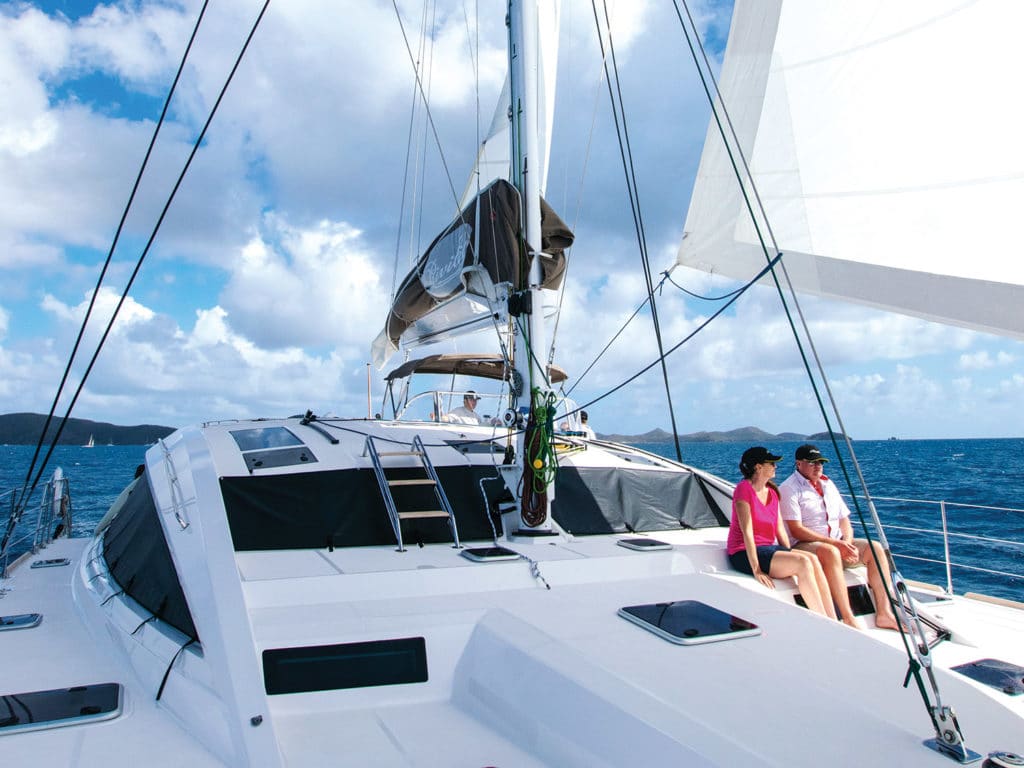
The Brauns are also looking forward to their upcoming adventures. Iris lit up when she spoke about their plans to circumnavigate and said that they’re excited “to see different places, countries and cultures and to meet various peoples around the world, especially since we can comfortably stay in various anchorages and be self-sufficient. Being together 24/7 and living in a space smaller than our house will take some getting used to however.”
Day three’s instruction focused on the topic that tends to cause the most stress: docking. With fenders deployed and under the patient guidance of Jules Lague, VSV’s docking coach, and Richard, each student managed to dock the big cat (“Just pretend it’s a shopping cart!” Richard explained).
Our course wrapped up Saturday afternoon with another sail and some celebratory “graduation” champagne, with the students feeling a sense of accomplishment and more prepared to launch into this next stage of their lives.
Jennifer Brett is CW’s senior editor.

